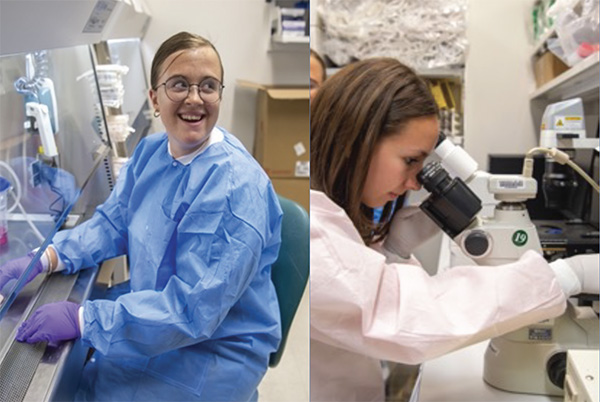
In the hallowed halls of scientific discovery at NIH, you will find two budding scientists, Alina Kenina and Megan Majocha. Kenina is a postbaccalaureate fellow and Majocha is a predoctoral fellow. Both are defying the odds and forging paths as deaf scientists at the National Cancer Institute (NCI) through Dr. Kent Hunter’s lab as part of the Deaf Scientists Training Program (DSTP).
The pair recently sat down with EDI to share their stories. They spoke about their early love for science, the obstacles they faced, and their unwavering optimism for the future.
Nurturing an interest from a young age
Since she was young, Kenina loved science, technology, engineering, and mathematics (STEM) and wanted to become a math teacher. In high school, she took an independent study in biology; this is the class that inspired her to pursue a career in science.
Kenina originally intended to major in exercise science at the Rochester Institute of Technology and become a physical therapist. However, she found a different way to further deaf women’s wellness when she applied for Dr. Hunter’s DSTP lab. Kenina was excited about the opportunity to develop her research skills, especially in an environment that prioritized providing accessibility to scientists.
Kenina explains, “Cancer biology is the topic I always wanted to learn, so I am thrilled to have the opportunity that blends my wants (the understanding of cancer biology) and needs (accessibility).”
Majocha had a similar experience.
She told EDI, “I was a curious kid, and I remember always asking my parents ‘why’ [in response] to everything.” Majocha would use online resources to find answers her parents could not provide and later took extra science credits in high school to advance her understanding. Earning those extra credits and participating in high school science fairs sparked Majocha’s interest and passion for science.
Majocha attended Gallaudet University for undergraduate studies, focusing on science and aspiring to be a genetic counselor. During her postbaccalaureate fellowship at NCI, she discovered how much she loved research. This led her to pursue a Ph.D. in Tumor Biology at Georgetown University.
“I went back to Dr. Hunter’s lab for my thesis research because I love the research, and the lab culture and accessibility are incredible here.”
Inspired to explore a world of possibilities
Both women draw inspiration from deaf individuals who have come before them. Kenina’s most influential role model is her deaf mother.
“She was a wonderful mother who encouraged and supported me to follow my passion for science. She made me the woman I am today. Doing cancer research is how I am healing and honoring her legacy,” Kenina explains after revealing her mother died from breast cancer. “I hope I will continue pursuing cancer research to contribute to deaf women’s wellness.”
Majocha shared that many deaf women scientists have served as role models throughout her life.
“I look up to every single one of them,” shared Majocha. “They have achieved success in a field that is dominated by hearing individuals, despite facing additional barriers due to their deafness.”
Rising above stereotypes to succeed in science
Throughout their careers, Majocha and Kenina, like other deaf individuals, have encountered limited access to resources and opportunities. Outside of NIH, there are numerous STEM programs and activities that do not always accommodate deaf people, making it challenging for them to fully engage. Additionally, misconceptions about the abilities and communication needs of deaf individuals often create hesitations in hiring them.
As a deaf scientist, Majocha shared, "There was one time when a scientist assumed my interpreter did all the experiments for me and helped me with lab work,” a misperception that could not be further from the truth. A sign language interpreter's role is to facilitate communication between signed and spoken languages. Majocha's experience underscores the importance of recognizing and addressing the intersectional challenges faced by scientists with disabilities.
Despite the challenges, both Kenina and Majocha remain committed to making an impact in the STEM field. They hope to inspire the next generation of deaf girls to pursue their passion for science and technology and never give up on their dreams.
One thing is certain: both Kenina and Majocha remain optimistic for the future. They passionately believe that, with support and advocacy, deaf women can overcome obstacles and achieve their career aspirations, regardless of the field they choose.
If you are an NIH employee or considering a career at NIH, learn more about the Office of Equity, Diversity, and Inclusion’s (EDI) Reasonable Accommodations Program and the support available to you.
Do you have a story idea for us? Do you want to submit a guest blog? If it's about equity, diversity, or inclusion, please submit to edi.stories@nih.gov.
For news, updates, and videos, subscribe or follow EDI on: Twitter, Instagram, Blog, YouTube.






